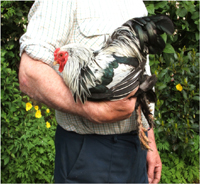Chicken Husbandry: Handling In order to maintain her place in the pecking order (ensures flock stability), a hen will disguise the fact that she is not feeling well. Handling on a regular basis is very important as it is the only way to tell if a bird has lost weight or not – even when really thin their feathers disguise this fact, so handling will give a vital early clue to any problems. Not only loss of weight but excess weight can be assessed by feeling the pin bones either side of the vent: they are sharp if the bird has little fat and well padded if too fat. For best production, fit not fat is the aim. The distance between the pin bones will indicate if the hen is laying: three vertical finger widths between the bones indicates production and less than two, the reverse.
The best handling method involves holding the hen so that she is comfortable and does not struggle or flap, thus protecting both her and yourself. If you first come across a hen in a cardboard box, slide your outstretched hand, palm up and fingers spread, blindly into the top of the box, then under her once located, her breast should rest on your outstretched palm, her legs between your first/second and third/fourth fingers which are then clenched firmly together. Your other hand is placed over her back to balance her as you lift her out of the box. Take the weight on your forearm and hold her close to your body, her head pointing towards your armpit, leaving your other hand free to inspect the bird. Be firm but don’t squeeze the body tightly as this may temporarily harm the breathing mechanism. This principle of holding applies to all species and all sizes of poultry – the bird is balanced and comfortable and the mucky end is away from you. The hip of any poultry will dislocate with horrifying ease if a bird is held by one leg. Do not hold them by the legs upside down.
If your first introduction to a hen is not in the confines of a box or crate, begin by practising in the dark with a very dim torch when the hens should be on their perch. If you move quietly and slowly, talking to them all the time, you will not startle them and you can then pick one hen off the perch with both hands around her wings and body, facing towards you. Then continue by sliding one hand under her as above. You are likely to need to catch a hen during daylight hours, so obtain a fishing landing net as this can (with practice and the aid of a fence or wall) be dropped over the hen and you can then pick her up as above. This is much less stressful for both you and the hen than chasing her around the pen or garden as she will be able to run and jink much faster than you. Hens can become really tame if correctly handled on a regular basis – some of them like sitting on a warm lap and watching television! |




